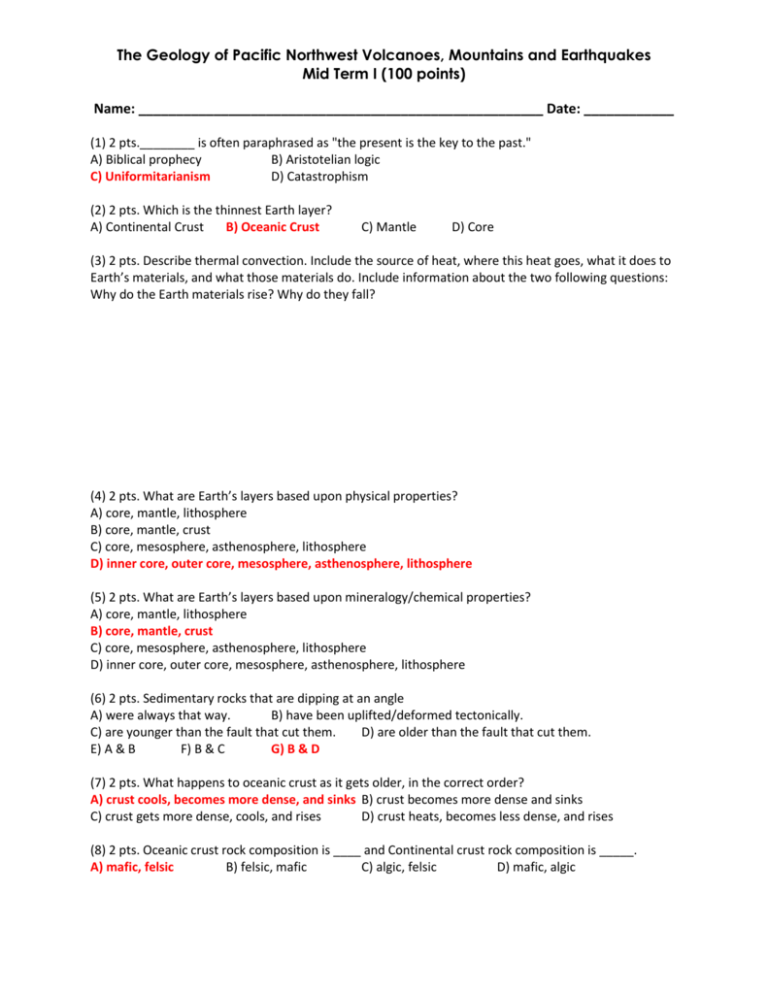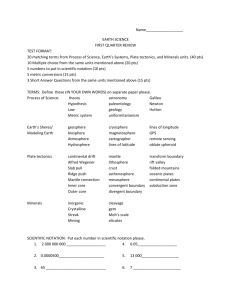GEO_142_mid_term_I_k..
advertisement

The Geology of Pacific Northwest Volcanoes, Mountains and Earthquakes Mid Term I (100 points) Name: ______________________________________________________ Date: ____________ (1) 2 pts.________ is often paraphrased as "the present is the key to the past." A) Biblical prophecy B) Aristotelian logic C) Uniformitarianism D) Catastrophism (2) 2 pts. Which is the thinnest Earth layer? A) Continental Crust B) Oceanic Crust C) Mantle D) Core (3) 2 pts. Describe thermal convection. Include the source of heat, where this heat goes, what it does to Earth’s materials, and what those materials do. Include information about the two following questions: Why do the Earth materials rise? Why do they fall? (4) 2 pts. What are Earth’s layers based upon physical properties? A) core, mantle, lithosphere B) core, mantle, crust C) core, mesosphere, asthenosphere, lithosphere D) inner core, outer core, mesosphere, asthenosphere, lithosphere (5) 2 pts. What are Earth’s layers based upon mineralogy/chemical properties? A) core, mantle, lithosphere B) core, mantle, crust C) core, mesosphere, asthenosphere, lithosphere D) inner core, outer core, mesosphere, asthenosphere, lithosphere (6) 2 pts. Sedimentary rocks that are dipping at an angle A) were always that way. B) have been uplifted/deformed tectonically. C) are younger than the fault that cut them. D) are older than the fault that cut them. E) A & B F) B & C G) B & D (7) 2 pts. What happens to oceanic crust as it gets older, in the correct order? A) crust cools, becomes more dense, and sinks B) crust becomes more dense and sinks C) crust gets more dense, cools, and rises D) crust heats, becomes less dense, and rises (8) 2 pts. Oceanic crust rock composition is ____ and Continental crust rock composition is _____. A) mafic, felsic B) felsic, mafic C) algic, felsic D) mafic, algic The Geology of Pacific Northwest Volcanoes, Mountains and Earthquakes Mid Term I (100 points) (9) 2 pts. Which is the most dense? A) continental crust B) oceanic crust C) core D) mantle (10) 2 pts. Which is the least dense? A) continental crust B) oceanic crust C) core D) mantle (11) 2 pts. In the diagram below, label each illustration with the correct type of volcano. Fissure Volcano, Stratovolcano, Shield Volcano, and Caldera Volcano A) Caldera Volcano B) Fissure Volcano C) Stratovolcano D) Shield Volcano (12) 2 pts. In the above examples, which is volcano has the highest Silica content? A) Fissure Volcano B) Stratovolcano C) Shield Volcano D) Caldera Volcano (13) 2 pts. In the above examples, which is volcano has the lowest Silica content? A) Fissure Volcano B) Stratovolcano C) Shield Volcano D) Caldera Volcano (14) 2 pts. The currently accepted age of the Earth is ________ years. A) 4.6 billion B) 4.6 thousand C) 6.4 million D) 6.4 trillion (15) 2 pts. Which of the following best describes the fundamental concept of superposition? A) Any sedimentary deposit accumulates on older rock or sediment layers. B) Older strata generally are deposited on younger strata without intervening, intermediate age strata. C) Strata with fossils are generally deposited on strata with no fossils. D) Older fossils in younger strata indicate a locally inverted geologic time scale. (16) 2 pts. Which of the following best describes the fundamental concept of cross cutting relations? A) Rocks are younger than a fault if they are cut by the fault. B) Processes that cut across geological units are older than those geological units. C) Processes that cut across geological units are younger than those geological units. D) Fossils are younger than a fault if they are cut by the fault. (17) 2 pts. All of the following are possible steps of scientific investigation EXCEPT for ________. A) the collection of scientific facts through observation and measurement B) assumption of conclusions without prior experimentation or observation C) development of observations and experiments to test the hypotheses D) the development of one or more working hypotheses or models to explain facts (18) 2 pts. The ________ forms the relatively cool, brittle plates of plate tectonics. A) geosphere B) asthenosphere C) astrosphere D) lithosphere The Geology of Pacific Northwest Volcanoes, Mountains and Earthquakes Mid Term I (100 points) (19) 2 pts. In correct order from the center outward, Earth includes which units? A) inner core, crust, mantle, hydrosphere B) core, crust, mantle, hydrosphere C) core, inner mantle, outer mantle, crust D) inner core, outer core, mantle, crust (20) 2 pts. The ________ is the thinnest layer of the Earth. A) inner core B) crust C) mantle D) outer core 13) ______ (21) 2 pts.________ rocks form by crystallization and consolidation of molten magma. A) Igneous B) Primary C) Sedimentary D) Indigenous (22) 2 pts.________ rocks always originate at the surface of the solid Earth. A) Secondary B) Sedimentary C) Igneous D) Metamorphic (23) 2 pts.________ is the process by which rocks break down in place to produce soils and sediments. A) Subduction B) Lithification C) Weathering D) Metamorphism (24) 2 pts. Which one of the following statements is NOT correct? A) Sedimentary rocks may weather to igneous rocks. B) Igneous rocks can undergo metamorphism. C) Magmas crystallize to form igneous rocks. D) Metamorphic rocks may melt to magma. (25) 2 pts. The asthenosphere is a relatively cool and rigid shell that overlies the lithosphere. T/F (26) 2 pts. According to the rock cycle, any type of rock (igneous, sedimentary, or metamorphic) may be transformed into another type of rock, given enough time. T/F (27) 2 pts. An unconformity is a buried ________. A) surface of erosion separating younger strata above from older strata below B) fault or fracture with younger strata above and older strata below C) surface of erosion with older strata above and younger strata below D) fault or fracture with older rocks above and younger rocks below (28) 2 pts. Which of the following best characterizes an angular unconformity? A) Horizontal lava flows lie below the unconformity, and horizontal, sedimentary strata lie above. B) Tilted strata lie below the unconformity with loose, unconsolidated soil above. C) Tilted strata lie below the unconformity, and bedding in younger strata above is parallel to the unconformity. D) It is the discordant boundary between older strata and an intrusive body of granite. (29) 2 pts. Sandstone strata and a mass of granite are observed to be in contact. Which of the following statements is correct geologically? A) The sandstone is younger if it shows evidence of contact metamorphism. B) The granite is older if it contains inclusions of sandstone. C) The granite is older if the sandstone contains pebbles of the granite. D) The sandstone is younger if the granite contains sandstone inclusions. The Geology of Pacific Northwest Volcanoes, Mountains and Earthquakes Mid Term I (100 points) (30) 2 pts. Assume that you have just examined several flat-lying sedimentary layers. After much study you determine that there is a considerable span of time for which no sedimentary rock layer exists at this site. You have just discovered a(n) ________. A) disconformity B) example of cross-cutting relationships C) series of conformable strata D) angular unconformity (31) 2 pts. What fundamental concept states that in a horizontal sequence of conformable sedimentary strata, each higher bed is younger than the bed below it? A) theory of correlative deposition B) law of original correlation C) law of superposition D) theory of superstition (32) 2 pts. The half-life of carbon-14 is about 6000 years. Assume that a sample of charcoal formed by burning of living wood 15,000 years ago. How much of the original carbon-14 would remain today? A) between 33% and 50% B) between 25% and 50% C) more than 50% D) between 12.5% and 25% (33) 2 pts. The percentage of radioactive atoms that decay during one half-life is always the same. T/F (34) 2 pts. After two half-lives there is no longer any of the original radioactive material remaining. T/F (35) 2 pts. After three half-lives, one-ninth of an original, radioactive parent isotope remains and eightninths has decayed into the daughter isotope. T/F (36) 4 pts. In the chart of radioactive decay shown at the right: (a) how many half-lives have elapsed by this time? __2__ (b) how many half-lives have elapsed by this time? __3__ (37) 2 pts. All of the following are evidence supporting the theory of plate tectonics EXCEPT for _______. A) hot spots B) paleomagnetism C) ocean floor drilling D) changes in the Moon's orbit due to shifting plates (38) 2 pts. Which of the following energy sources is thought to drive the lateral motions of Earth's lithospheric plates? A) electrical and magnetic fields localized in the inner core B) swirling movements of the molten iron particles in the outer core C) export of heat from deep in the mantle to the top of the asthenosphere D) gravitational attractive forces of the Sun and Moon The Geology of Pacific Northwest Volcanoes, Mountains and Earthquakes Mid Term I (100 points) (39) 2 pts. Pull-apart rift zones are generally associated with a ________ plate boundary. A) convergent B) divergent C) transform D) all plate boundaries (40) 2 pts. New oceanic crust and lithosphere are formed at ________. A) divergent boundaries by submarine eruptions and intrusions of basaltic magma B) convergent boundaries by submarine eruptions and intrusions of basaltic magma C) divergent boundaries by submarine eruptions and intrusions of rhyolitic magma D) convergent boundaries by submarine eruptions and intrusions of rhyolitic magma (41) 2 pts. The volcanoes and deep valleys of east Africa are related to a ________. A) continental collision zone between Africa and the Zagros Mountains along the southern margin of Eurasia B) transform fault aligned with the Red Sea carrying the Arabian and African blocks in opposite directions C) continental rift along which parts of the African continent are beginning to slowly separate D) fault allowing Arabia to slip westward past east Africa and penetrate into Turkey (42) 2 pts. The ________ is an example of an active, continent-continent collision. A) westward movement of the South American plate over the Nazca plate B) Arabian Peninsula slamming into North Africa under the Red Sea C) northern movement of Baja California and a sliver of western California toward the Hawaiian Islands D) northward movement of India into Eurasia (43) 2 pts. Linear, magnetic patterns associated with mid-ocean ridges are configured as ________. A) reversed magnetizations along the rift valleys and normal magnetizations along the ridge B) normal and reversed magnetized strips roughly parallel to the ridge C) normal and reversed magnetized strips roughly perpendicular to the ridge axis D) concentric circles about a rising plume of hot mantle rocks and magma (44) 2 pts. The distance between the modern Hawaii Volcano (Mauna Loa = 0 years old) and the island that is circled is 3,200 km. What is the plate motion rate for the past 30 million years? (Round your answer to the nearest mm.) A. 156 mm/year B. 458 mm/year C. 107 mm/year D. 352 mm/year The Geology of Pacific Northwest Volcanoes, Mountains and Earthquakes Mid Term I (100 points) (45) 2 pts. Fill in the blanks with the correct name of the feature that is labeled. Delete these (a) oceanic trench (b) oceanic ridge (c) oceanic trench (d) subduction zone (e) transform faults (46) 2 pts. In the diagram below, label each illustration with the correct type of plate boundary. Convergent, Transform, Divergent TRANSFORM DIVERGENT CONVERGENT The Geology of Pacific Northwest Volcanoes, Mountains and Earthquakes Mid Term I (100 points) (47) 2 pts. In the diagram below, label each illustration where you would find each type of volcano: Shield Volcano, Rift Volcano, Stratovolcano, Fissure Volcano Stratovolcano Fissure Volcano Rift Volcano Shield Volcano (48) 2 pts. List the units and processes from oldest to youngest. Delete this: A B C D E L K M F G H J I







